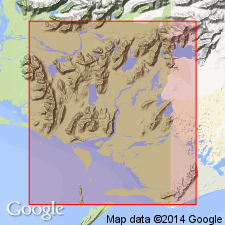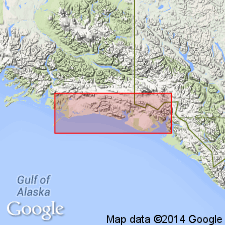
- Usage in publication:
-
- Stillwater formation*
- Modifications:
-
- Named
- Dominant lithology:
-
- Shale
- Sandstone
- AAPG geologic province:
-
- Alaska Southern region
Summary:
Occupies entire valley of Stillwater Creek and extends for some distance up valleys of Trout and Clear creeks, eastward to Canyon Creek and westward throughout Shockum Mountains, also on shores of Berg Lakes, west shore of Kushtaka Lake and in mountain north of Bering Lake, Controller Bay region, southern AK. Consists of shale and sandstone over 1000 ft thick. Base has not been recognized. Probably conformably underlies Kushtaka formation. List and localities of fossils identified by W.H. Dall included. Age given as Tertiary.
Source: GNU records (USGS DDS-6; Menlo GNULEX).

- Usage in publication:
-
- Stillwater Formation*
- Modifications:
-
- Age modified
- Biostratigraphic dating
- AAPG geologic province:
-
- Alaska Southern region
Summary:
Age is middle Eocene on basis of collection of mollusks from unit in Shockum Mountains and elsewhere (F.S. MacNeil, written commun., Oct. 24, 1961; MacNeil and others, 1961, p.1803). Unit also listed in correlation table of plant localities as of Fultonian Stage (middle Eocene). [Type section mentioned but no location given.]
Source: GNU records (USGS DDS-6; Menlo GNULEX).
For more information, please contact Nancy Stamm, Geologic Names Committee Secretary.
Asterisk (*) indicates published by U.S. Geological Survey authors.
"No current usage" (†) implies that a name has been abandoned or has fallen into disuse. Former usage and, if known, replacement name given in parentheses ( ).
Slash (/) indicates name conflicts with nomenclatural guidelines (CSN, 1933; ACSN, 1961, 1970; NACSN, 1983, 2005, 2021). May be explained within brackets ([ ]).

